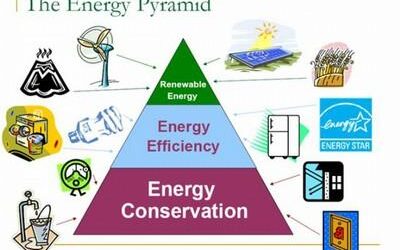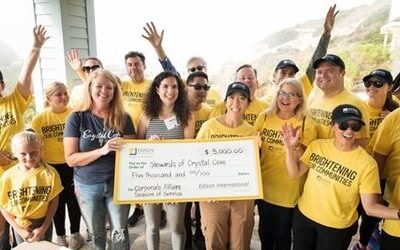Within every color television, computer chip – even corning ware glass and catalytic converter – are particles refined from so-called rare earth mining.
Chances are they were dug in the Mojave Desert.
At the Molycorp Mine at Mountain Pass, along Interstate 15 about 30 miles from the California-Nevada state line, 250 people excavate, separate and ultimately refine tons of ore every week.
Miners look for lanthanides, a family of 15 elements that are used in a variety of ways. Molycorp is the only mine in the world devoted exclusively to the production of lanthanides, mine manager Robert Sega said.
“Other mines produce lanthanides as a by-product, but we’re the only facility in the world developed solely for the long-term production of lanthanides,” Sega said.
Eight of the elements are mined for commercial use.
Europium oxide, a derivative of lanthanide, provides the red in color televisions, while another, cerium carbonite, is used in catalytic converters and yttrium concentrate is used in conductor chips. Still other elements provide the color in glassware and are used in lighter flints and X-ray machines.
From an open pit first excavated in 1951, a bastinasite ore rich in lanthanides is mined and sent to a mill for the first step in refining. From there the ore is led to a hopper and sent through a maze-like structure for sifting, crushing and delivery to a stockpile.
The pile then proceeds through a series of steps, from flotation in triple deionized water to heating, to get the end product for marketing.
While the Molycorp mine led the way in lanthanides until 1988, China – able to work with cheap labor – has since emerged as the leader and been able to undercut the local mine’s prices. That has prompted fierce competition between Molycorp, a wholly owned subsidiary of Unocal, and foreign producers.
Also threatening Molycorp, Sega said, is the California Desert Protection Act, now making its way through Congress under the tutelage of Sen. Dianne Feinstein of California. If the act is approved, it would threaten exploration outside of the existing pit, he said.
“This is the only pure rare earth mine in the free world,” Sega said.
The deposit was first discovered in 1949 and was bought by Molycorp in 1951 at a time when the only uses for the minerals were thought to be lighter flints and glass polishers. It was operated at a minimum until the early 1960s, when television began to take hold.
Sega is very open and free to talk about the mine and what it means to the region. Recently, he gave a pair of visitors a three hour-long tour of the sprawling operation and its inner workings. There are certain things he is not free to discuss, such as prices charged customers. Prices are kept top secret because of the competition.
Leading visitors through the different buildings that make up the complex, Sega and his guests eventually found themselves navigating narrow catwalk-like pathways high above vats of liquid.
One visitor was visibly startled by the sudden noise coming from the direction of conveyer belt perhaps 40 feet below.
Sega said the operations at Molycorp are vital to the United States and to the world, providing employment and supplies critical to electronics production for private industry and the military.
However, he said operation of the mine might be in jeopardy in years to come if the desert bill is passed. Exploration outside of the existing pit alongside an 80 foot-long Strip Molycorp holds claim to would likely be restricted, if not completely banned, he said.
“When this ore body runs out, we’re dependant on China,” Sega said. “Is this a situation the United States wants to get itself into with regard to mineral rights?”
He said politicians like Sen. Dale Bumpers of Arkansas, who is proposing his own version of the desert bill to cover his home state, have no regard for the mining industry and for the economic benefit it provides. That flies in the face of an 1872 law encouraging citizens to prospect on public lands.
“Sen. Bumpers was told environmental restrictions would force mining south of the border,” Sega recalled. What was his response? ‘Adios.’”
Some people apparently agree with the senator.
Peter Burk, a Barstow resident and vice chairman of the Sierra Club Desert Committee, said he understands Molycorp is a major rare earth mine. However, he said mining in general is a dying industry whose workers destroy the earth and environment.
“Molycorp is a world class earth mine — it’s one of the most important in the world,” he said. “But it’s the worst toxic waste producer. It’s been fined the highest of all mines for environmental violations.”
Contrary to Sega’s claim that the primary pit contains only a 20- to 30-year supply of lanthanides, Burk said geological studies have shown that it contains another 250-year lode which miners will able to excavate.
Unocal spokesman Art Bentley in Los Angeles said the company does not yet know precisely how the desert protection bill would affect operations. But he disputed Burke’s claims that the company is not environmentally sensitive.
He said the company was fined $400,000 in 1992 by the state Department of Toxic Control for violating hazardous waste storage requirements. However, the problem was corrected, he said. The mine has cut back dramatically on the amount of ammonium nitrate discharged into wastewater ponds on company property, from 5.7 million pounds in 1991 to about 600,000 in 1992.
As evidence of Molycorp’s sensitivity to the environment, Sega said Unocal relocated Joshua trees to a site formerly used as a campsite for mine workers, and paid $600,000 for a desert tortoise study.
“Unocal is a stickler for following environmental rules and regulations,” he said.
Bentley reiterated that the outcome of the desert protection bill remains uncertain.
“We don’t have a crystal ball,” he said. “We can’t be sure because the legislation hasn’t been passed by Congress. Until it is passed, if it is passed, there’s no way to be sure.”
A spokesman for Feinstein in Washington said that as the desert bill is currently proposed, existing mines – such as the open pit at Molycorp – would not be affected.




0 Comments